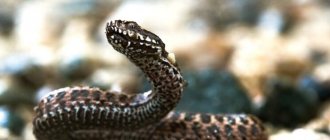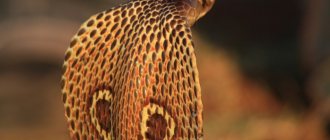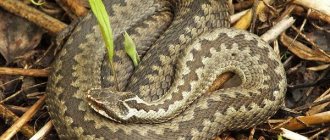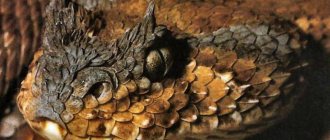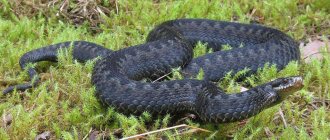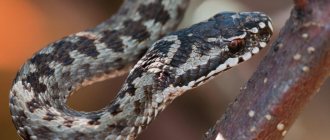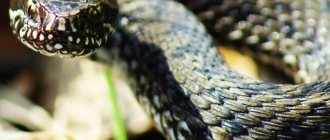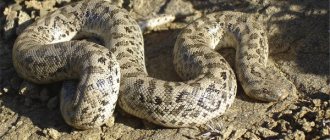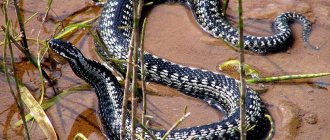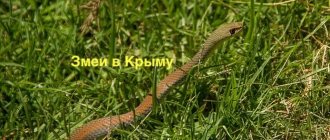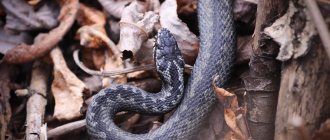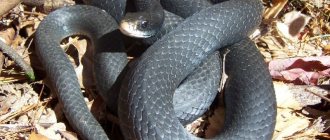- What do vipers eat in the wild?
If we take it on a global scale, then the viper is far from the most dangerous poisonous snake; it cannot compete with the same Asian
cobras, not to mention American rattlesnakes, which have an instant reaction and deadly poison, an unsuccessful encounter with which has a very high chance of becoming your last. But, nevertheless, among the reptiles that live in our latitudes, the viper is the most dangerous. Speaking of the name of this snake, the word “viper” goes back to ancient times and literally comes from the word “reptile”, which meant disgusting animals, which is the heroine of our article today.
Viper: description, structure, characteristics. What does a viper look like?
Most species of vipers have a wide but short body. The greatest length to which adults grow is 3-4 meters, and their weight can reach 16 kg. The minimum length of a developed snake is around 30 cm, and its weight does not exceed a kilogram.
Flattened head of a snake with a vertical pupil in the eye
Vipers are easily distinguished from other snakes by the structure of their heads. In all species, the skull is flattened above and below, and protrusions are visible on the cheekbones. An arched nose may contain large scales that differ in appearance from those located on the body.
In front of the protruding cheekbones are small eyes with vertical pupils.
Vipers have good eyesight, allowing them to clearly see what is happening around them. Fun fact : At night, the snake's pupils dilate completely, filling the entire eye, allowing it to see well in the dark.
Each species has a unique color. Snakes wear black, brown, orange and other dark colors. There may also be a pattern on the back. The appearance of the snake depends on its habitat. The color on the body is formed in such a way that the individual is less noticeable. This allows you to sneak up on prey.
There are two fangs on the upper jaw, from which the poison is released. The latter is produced with the help of glands located inside the gums. The fangs can grow up to 5 cm in length. When the snake's mouth is closed, they are pressed to the upper gum and are in a special film. When the jaws open, the fangs move down.
What do vipers eat in the wild?
Vipers lead an exclusively predatory lifestyle. Thanks to their coloring, which allows them to blend into the terrain, they quietly creep up to the target and hide in ambush. When the right moment comes, the snake throws itself forward with its mouth wide open. She bites into her prey with her fangs, injecting poison.
Interesting fact : Most species of vipers are nocturnal predators. In the dark it is easier for them to remain unnoticed and sneak up.
After being bitten, the enemy stops resisting within a few minutes. The snake just needs to be nearby and wait until it can start eating. The viper swallows its prey whole, after which it goes to a secluded place to digest it.
The predator chooses frogs, lizards, rodents and birds as targets. Young snakes can feed on insects, and when they become sufficiently developed, they also switch to larger foods.
Nutrition
The viper is a notorious predator, and also leads a nocturnal lifestyle. These snakes prefer to attack their prey from an ambush, quickly biting it with their poisonous fangs; the poison kills the victim within a few minutes, then the viper begins its meal, usually swallowing the prey whole.
The main menu of the viper is a variety of small rodents,
lizards, marsh frogs, some birds. Small vipers feed on large beetles, locusts, and can catch caterpillars and butterflies.
Natural enemies of vipers
The badger is one of the enemies of the viper, which does not mind eating its meat
. Although the viper has poisonous fangs, there are animals that are not afraid to challenge it and engage in a duel. Foxes, badgers and ferrets do not mind eating snake meat, so they openly attack it. The Viper can offer resistance, but its signature throw is not always enough to emerge victorious from the fight. Often the opponent manages to grab the base of its head with his mouth, and then the snake becomes defenseless.
Interesting fact : the most dangerous enemy for the viper is the wild boar. It is not affected by poison, so the snake, in principle, cannot offer any resistance.
Predators among birds also often attack the gillback. Among them are an eagle, an owl, a heron and a stork. Surprisingly, the hedgehog is also among the snake's natural enemies. He doesn't mind eating her meat and is the first to attack if he meets her. It is difficult for a snake to fight a hedgehog, because... During the throws, she bumps into needles with her muzzle.
Other extinction issues
But it is not only the destruction of the natural habitat, but also the sheer malice of man that is partly responsible for the gradual extinction of this species. Many people still believe that it is completely normal to kill both vipers and other snakes for fun.
Wild boars also often search for food under branches, where they encounter and kill snakes.
In addition, they serve larger animals such as birds of prey and mammals as a natural food source. Sometimes, even domestic cats become a real danger to snakes.
Another problem is the fragmentation of forests due to construction and highways, which surround the remaining habitats and thus provide genetic impoverishment.
How long does a viper live?
In an artificial habitat, with proper care, a snake lives much longer.
Representatives of most species of vipers can live for about 15 years. With rare exceptions, the age of the snake is approaching 30 years. But for this, it must exist in comfortable conditions, where there is no danger and no need to constantly hunt. Therefore, long-lived vipers are found mainly in zoos.
Interesting: Badger
